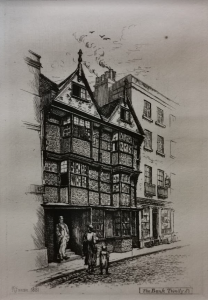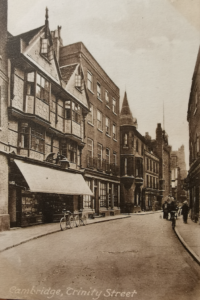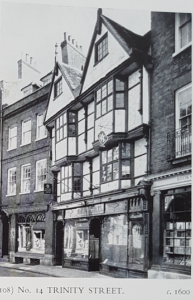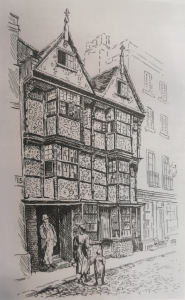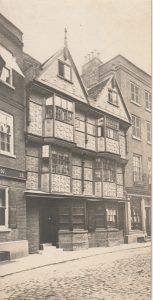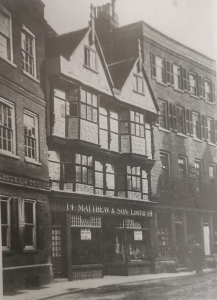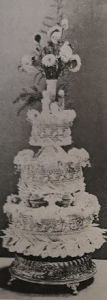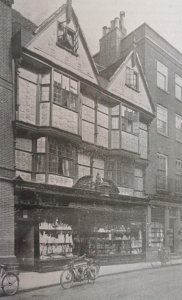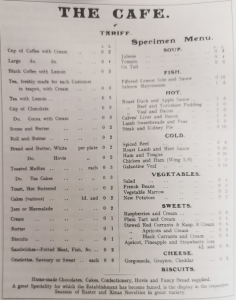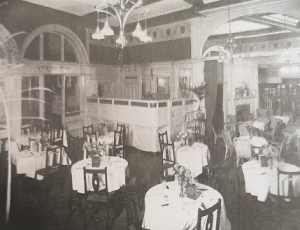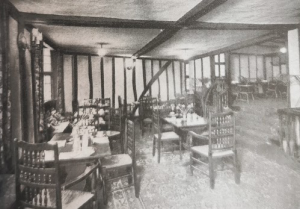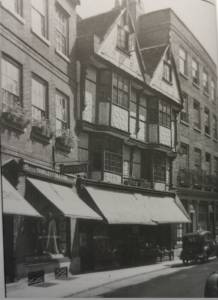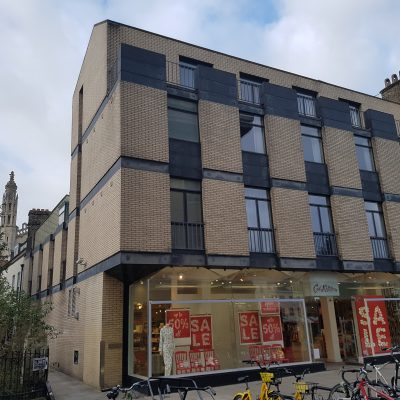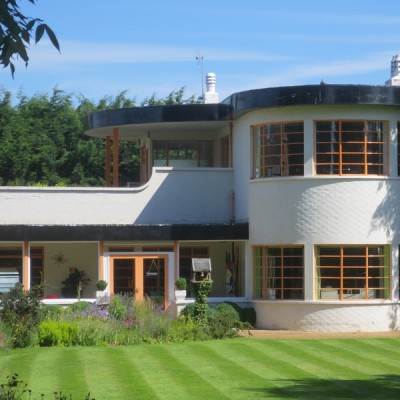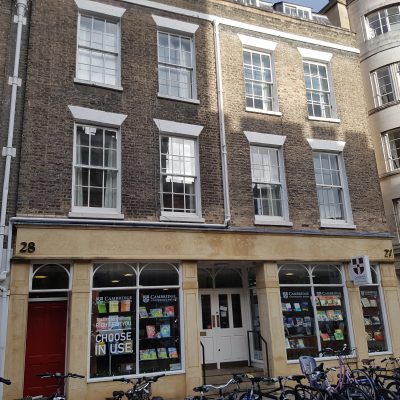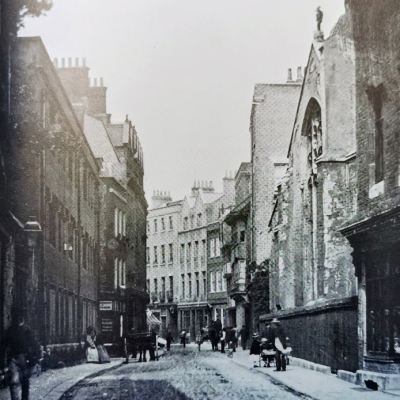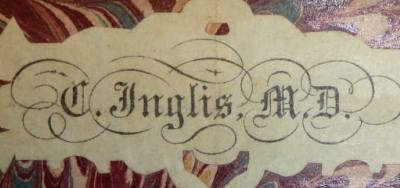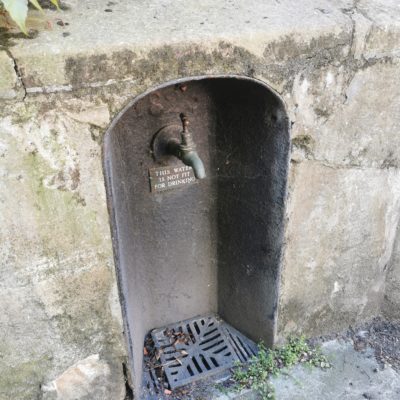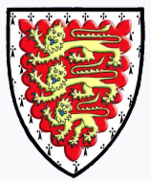Search by topic
- archaeology
- Building of Local Interest
- chapel
- charity
- church
- crime
- dressmaker
- fire
- Great Eastern Railway
- Listed building
- Mapping Relief
- medieval
- oral history
- poverty
- Public House
- Religious House
- Roman
- scholar
- school
- Then and Now
- tudor
- women
- work
- world war one
- world war two
Search by text
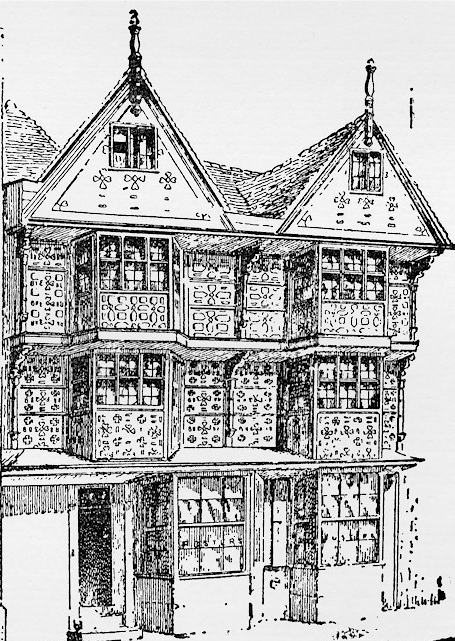 Turk's Head Coffee House c1876
Turk's Head Coffee House c187614 Trinity Street (Turk’s Head Inn)
History of 14 Trinity Street
Once the Turk’s Head Inn (much restored), no. 14 shows the heights achieved by Cambridge builders by c.1600. Timber-framed with raised pargeting, it has overhanging upper storeys, two overhanging gables and canted oriel windows. (Pevsner)
The access to the site from Green Street
UK Census and other sources:
17th century
This was a well known coffee house.
1835
13/8/1954 This year marks the 150th anniversary of Lloyd’s Bank in Cambridge. In 1804 two brothers named Foster who were already trading as millers established a bank in Bridge Street. In 1835 they transferred to the Turk’s Head in Trinity Street and opened branches in St Ives, Saffron Walden and Ely. In those days two members of staff were boarded on the premises, one sleeping on a bed in front of the strong room armed with a rusty sword. At no time was the building left unattended. In 1890 they acquired a site at the junction of Hobson Street and a new building in Renaissance style was opened in 1894. The Capital and Counties Bank took them over in 1904 and 14 years later they amalgamated with Lloyd’s. In 1919 the two offices were merged and the Sidney Street premises chosen as the main branch. In 1935 a considerable extension was built on the corner site. (Cam. News)
1861
John Paterson Gardner, 54, bankers clerk, b Northants
1891
David James Scott, widower, 62, banker’s clerk, b Cambridge
Elizabeth Alice, 28, b Cambridge
Edith M Glover, 22, servant, b Madingley
Thirza Thompson, 19, servant, b Madingley
Albert John Chivers, boarder, 21, banker’s clerk, b Cottenham
1896
Arthur Matthews committed the firm to a 21 year lease of the premises from the Foster brothers at £300 per annum, one of the conditions was that Matthews was not to use any part of the building as a bank.
‘Oriental Cafes’ were fashionable in a number of towns at the time. Matthew’s cafe was lit throughout by electric light. The decor made prominent use of the star and the crescent.
1901
1902
1910
1911
Mrs Pollock family away
1913
The Cafe Luncheon and Smoking Rooms
The Great North Magazine described the cafe in 1913 as: The finest by far in the eastern Counties, with all its various apartments, all beautifully furnished, the snow-white table linen, the spruce waiting maids.
1923
By the 1920s the ambience had changed, there were no longer oriental themes but instead a frieze of college crests. Upstairs the decoration of the Oak Room made a feature of the original oak beams.
In early September 1923 four Rugger enthusiasts met at Bunty’s Cafe to discuss forming a club. The source of the name ‘Bunty’s’ is unknown at present but the inaugural meeting of the club was then held at the Cafe in Trinity Street on 11 September 1923.
1927
CDN 29.10.1927: The fascinating experience of lunching in Cambridge in the atmosphere of our Elizabethan forefathers is made possible by the opening of new rooms at Messrs Matthew’s Cafe in Trinity Street.
1937
Matthew’s Restaurant
21/5/1976 The Turks Head Berni Inn, Trinity Street, Cambridge, sucks inside an almost relentless stream of visitors. The upstairs bar serves ducking and scampi but we were heading for the simple steak sort of menu. Our two schooners of sherry cost 32p each and the wine, Cotes de Rhone, £2.34. The food was worth a wait. We had rump steak (£1.91) and a fillet steak (£2.73) which were very tasty, with chips, peas and tomatoes. We followed up with chocolate ice creams, which were included in the main course price. We could have had instead cheese and biscuits. Other offerings were Dover sole (£2.44) and Sirloin steak (£1.89).(Cam.News)
At some point 1970s there was a disastrous fire. All that was left was the front of the building and the university proposed to demolish that as well. However, it was rebuilt and Laura Ashley set up business there.
2018
Jigsaw
Contribute
Do you have any information about the people or places in this article? If so, then please let us know using the Contact page or by emailing capturingcambridge@
License
This work is licensed under CC BY-NC-SA 4.0





